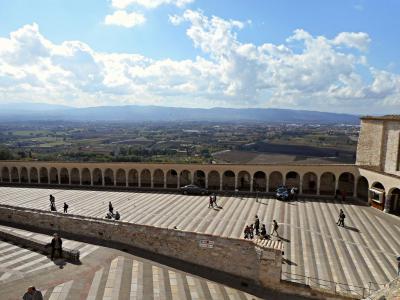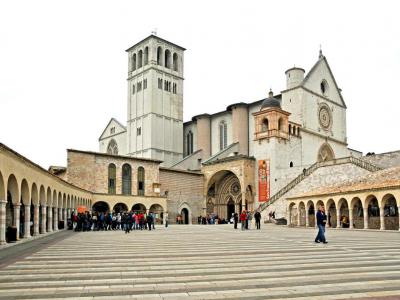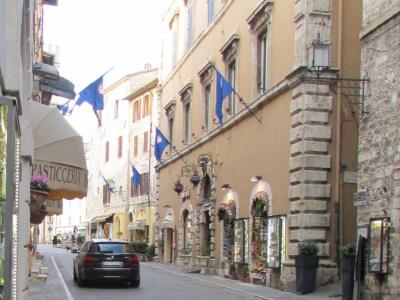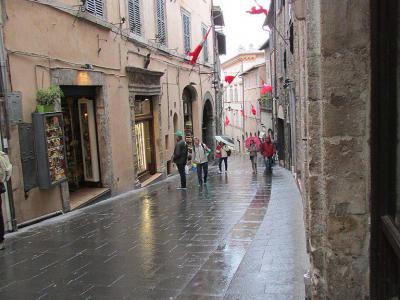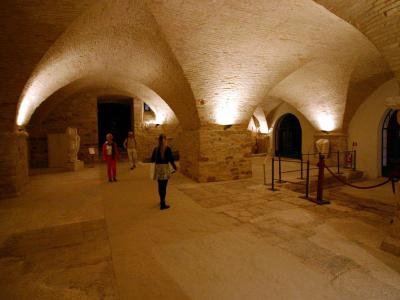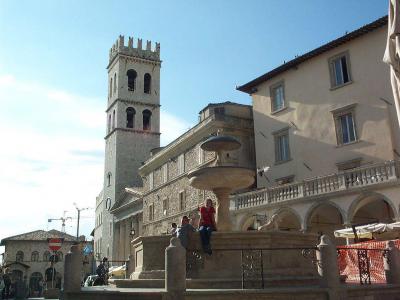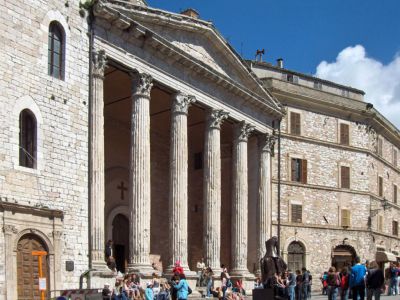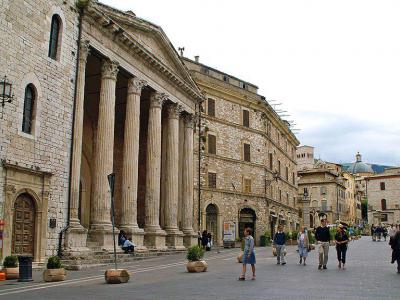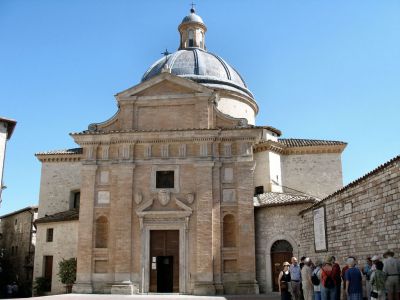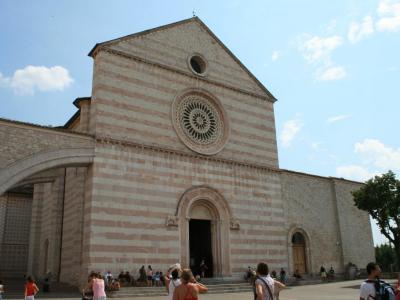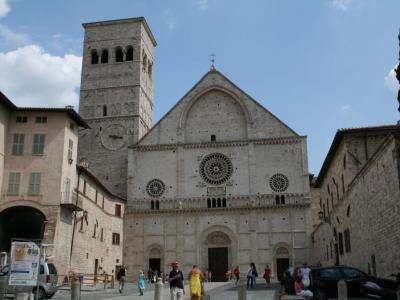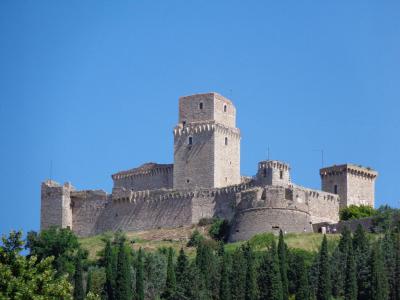Assisi Introduction Walking Tour (Self Guided), Assisi
Assisi is located on the western slope of Mount Subasio. It is 1,300 feet above sea level, overlooking the rivers Topino and Chiasicio. It is a walled city with narrow, twisting streets and alleys. It originally was known as Assisium. Successively Umbrian, Etruscan and Roman, it became a Ghibelline commune in the 11th century.
There were clashes with Guelph Perugia. In the battle of Collestrada, a young man named Francesco de Bernardone was taken prisoner. He was held for a year. He had changed. He renounced the world, became a mendicant, devoted to prayer and meditation. He is known today as Saint Francis of Assisi.
Tourists and pilgrims flock to churches, shrines, and palaces in the city. The Basilica of Saint Francis of Assisi is divided into upper and lower churches. The lower church holds the body of Saint Francis.
Santa Maria sopra Minerva is a church built on the old Temple of Minerva. Underneath the church is part of a Roman forum. The Basilica of Saint Clare, the Papal Basilica of Saint Mary of the Angels, the New Church, Hermitage of the Prisons and San Damiano Church all represent stations in the lives of the saints.
There is the medieval castle of Major Fortress, towering over the city. A Roman amphitheater, piazzas, fountains and museums must be added to the list.
Experience both medieval and modern Assisi. The Calendimaggio Festival occurs in the first four days in May ending on Saturday. It includes processions, theatre, Choirs, cross bows, dancing and flag contests. And there is more. Come and find out.
There were clashes with Guelph Perugia. In the battle of Collestrada, a young man named Francesco de Bernardone was taken prisoner. He was held for a year. He had changed. He renounced the world, became a mendicant, devoted to prayer and meditation. He is known today as Saint Francis of Assisi.
Tourists and pilgrims flock to churches, shrines, and palaces in the city. The Basilica of Saint Francis of Assisi is divided into upper and lower churches. The lower church holds the body of Saint Francis.
Santa Maria sopra Minerva is a church built on the old Temple of Minerva. Underneath the church is part of a Roman forum. The Basilica of Saint Clare, the Papal Basilica of Saint Mary of the Angels, the New Church, Hermitage of the Prisons and San Damiano Church all represent stations in the lives of the saints.
There is the medieval castle of Major Fortress, towering over the city. A Roman amphitheater, piazzas, fountains and museums must be added to the list.
Experience both medieval and modern Assisi. The Calendimaggio Festival occurs in the first four days in May ending on Saturday. It includes processions, theatre, Choirs, cross bows, dancing and flag contests. And there is more. Come and find out.
How it works: Download the app "GPSmyCity: Walks in 1K+ Cities" from Apple App Store or Google Play Store to your mobile phone or tablet. The app turns your mobile device into a personal tour guide and its built-in GPS navigation functions guide you from one tour stop to next. The app works offline, so no data plan is needed when traveling abroad.
Assisi Introduction Walking Tour Map
Guide Name: Assisi Introduction Walking Tour
Guide Location: Italy » Assisi (See other walking tours in Assisi)
Guide Type: Self-guided Walking Tour (Sightseeing)
# of Attractions: 12
Tour Duration: 2 Hour(s)
Travel Distance: 1.9 Km or 1.2 Miles
Author: leticia
Sight(s) Featured in This Guide:
Guide Location: Italy » Assisi (See other walking tours in Assisi)
Guide Type: Self-guided Walking Tour (Sightseeing)
# of Attractions: 12
Tour Duration: 2 Hour(s)
Travel Distance: 1.9 Km or 1.2 Miles
Author: leticia
Sight(s) Featured in This Guide:
- Piazza Inferiore di San Francesco (Lower Square of St. Francis)
- Basilica di San Francesco d'Assisi (Basilica of Saint Francis)
- Pinacoteca Comunale (Municipal Picture Gallery)
- Via Portica (Portica Street)
- Museo e Foro Romano (Roman Forum and Archaeological Museum)
- Palazzo del Capitano del Popolo (Captain of the People's Palace / People's Tower)
- Chiesa di Santa Maria sopra Minerva (Church of St. Mary above Minerva)
- Piazza del Comune (Town Hall Square)
- Chiesa Nuova (New Church)
- Basilica di Santa Chiara (Basilica of St. Clare)
- Cattedrale di San Rufino di Assisi (Assisi Cathedral)
- Rocca Maggiore (Major Fortress)
1) Piazza Inferiore di San Francesco (Lower Square of St. Francis)
This square is like the warm-up spot before diving into the Basilica of Saint Francis, offering the most scenic views of both the complex and the lush Umbrian fields below. It was built around the same time as the basilica, and in the 15th and 16th centuries, they added the porticoes with hexagonal columns to accommodate pilgrims and sellers. Along with the geometric floor made of variously colored stone, these porticoes create a nice perspective play. Partly rebuilt in the 16th century, they were somewhat shaken by the earthquake of 1997.
In any case, the square is quite spacious and perfect for taking some awesome shots, with the Umbrian sky as a background. Its shape is reminiscent of a Renaissance version of a medieval cloister, longer than it is wide. If you head north, there's a steep staircase and a slope leading to the Upper Square. Oh, and there's also an info spot with audio guides, plus bathrooms attached, so you're pretty much all set.
In any case, the square is quite spacious and perfect for taking some awesome shots, with the Umbrian sky as a background. Its shape is reminiscent of a Renaissance version of a medieval cloister, longer than it is wide. If you head north, there's a steep staircase and a slope leading to the Upper Square. Oh, and there's also an info spot with audio guides, plus bathrooms attached, so you're pretty much all set.
2) Basilica di San Francesco d'Assisi (Basilica of Saint Francis) (must see)
Since its construction in 1228, the Basilica of Saint Francis has held major significance as a site of Catholic pilgrimage worldwide. Aside from enshrining the body of the venerated saint beneath the high altar, its collection of paintings by Giotto is renowned for its role in Western art history, transitioning from Byzantine stylization to humanist narrative, realism, and three-dimensionality. Depicting scenes from the life of the saint and other biblical narratives, these paintings have influenced generations of artists and continue to captivate.
Architecturally, the basilica is structured in two tiers, with the Upper Church above the Lower Church. This extraordinary feat presented significant engineering challenges, which were ingeniously addressed through the use of massive arched buttressing. While the original creator remains unknown due to the destruction of original drawings in a raid by the Perugians, it is commonly attributed to Lombard masons inspired by Gothic churches in southern France. The structure's design, particularly its single-naved Upper Church, served as a model for countless Franciscan churches across Italy.
Both churches are adorned with exquisite frescoes, making them veritable artistic treasure troves. The Lower Basilica exudes a dimly lit ambiance, while the Upper one is characterized by its brightness and spaciousness. Giotto's frescoes in the Upper Church, painted when he was still in his twenties, mark him as a pivotal figure in the evolution of Western painting. Additionally, the Lower Church boasts frescoes by esteemed painters Simone Martini and Pietro Lorenzetti, alongside those by Giotto or his assistants.
Visitors should adhere to the basilica's strict dress code, which prohibits bare shoulders or knees. To avoid crowds, it is advisable to visit early or late in the day, ensuring a more serene experience amid the awe-inspiring ambiance.
Architecturally, the basilica is structured in two tiers, with the Upper Church above the Lower Church. This extraordinary feat presented significant engineering challenges, which were ingeniously addressed through the use of massive arched buttressing. While the original creator remains unknown due to the destruction of original drawings in a raid by the Perugians, it is commonly attributed to Lombard masons inspired by Gothic churches in southern France. The structure's design, particularly its single-naved Upper Church, served as a model for countless Franciscan churches across Italy.
Both churches are adorned with exquisite frescoes, making them veritable artistic treasure troves. The Lower Basilica exudes a dimly lit ambiance, while the Upper one is characterized by its brightness and spaciousness. Giotto's frescoes in the Upper Church, painted when he was still in his twenties, mark him as a pivotal figure in the evolution of Western painting. Additionally, the Lower Church boasts frescoes by esteemed painters Simone Martini and Pietro Lorenzetti, alongside those by Giotto or his assistants.
Visitors should adhere to the basilica's strict dress code, which prohibits bare shoulders or knees. To avoid crowds, it is advisable to visit early or late in the day, ensuring a more serene experience amid the awe-inspiring ambiance.
3) Pinacoteca Comunale (Municipal Picture Gallery)
The Vallemani Palace, a neat example of 16th-century Baroque architecture, houses the remarkable Municipal Picture Gallery, definitely worth the entrance fee. Among its treasures is the remarkable "Immaculate Conception of the Virgin" (1495–1505) by Matteo da Gualdo, along with many detached frescoes rescued from churches and buildings across Assisi, including significant works by Ottaviano Nelli.
Keep an eye out for a particularly intriguing fresco by an anonymous 14th-century Umbrian artist depicting Saint Julian (San Giuliano) inadvertently killing his parents, mistaking them for his wife and her lover upon his return home. The artist seems to relish portraying the graphic and exaggerated wounds with a hint of macabre delight.
Venture upstairs to explore the Museum of Memory ("Museo della Memoria"), spanning four rooms dedicated to examining the history of Assisi's Jewish community from 1941 to 1943. During this tumultuous period, the efforts of the Franciscans played an essential role in saving the lives of about three hundred individuals in and around the town.
Keep an eye out for a particularly intriguing fresco by an anonymous 14th-century Umbrian artist depicting Saint Julian (San Giuliano) inadvertently killing his parents, mistaking them for his wife and her lover upon his return home. The artist seems to relish portraying the graphic and exaggerated wounds with a hint of macabre delight.
Venture upstairs to explore the Museum of Memory ("Museo della Memoria"), spanning four rooms dedicated to examining the history of Assisi's Jewish community from 1941 to 1943. During this tumultuous period, the efforts of the Franciscans played an essential role in saving the lives of about three hundred individuals in and around the town.
4) Via Portica (Portica Street)
A neatly paved and well-maintained street, Via Portica serves as a direct route to or from the Basilica of Saint Francis, thoughtfully adorned with spacious porticoes for shelter. These countless porticoes, along with the alternating dark and light stripes of the flooring, offer a delightful stroll, particularly enchanting in the evening when they're bathed in illumination, creating captivating interplays of light and shadow. During the festive Christmas season, the street further dazzles with a grand illuminated tree and a life-sized nativity scene.
Beyond the array of shops and eateries lining it, Via Portica also grants access to the Roman Forum and Archaeological Museum, providing a welcome retreat from urban life and allowing visitors to indulge in a moment of tranquility.
Tip:
Make sure not to overlook Negozio Il Lavandeto at #16 – the scent of lavender wafts from the store, impossible to miss. Here, you can find an extensive array of products featuring this wonderfully fragrant flower. Additionally, don't forget to explore Colori del Tempo at #6, offering an exquisite collection of original clothing and accessories, including shoes, bags, earrings, and necklaces, all impeccably curated and offered at reasonable prices, a rare find indeed.
Beyond the array of shops and eateries lining it, Via Portica also grants access to the Roman Forum and Archaeological Museum, providing a welcome retreat from urban life and allowing visitors to indulge in a moment of tranquility.
Tip:
Make sure not to overlook Negozio Il Lavandeto at #16 – the scent of lavender wafts from the store, impossible to miss. Here, you can find an extensive array of products featuring this wonderfully fragrant flower. Additionally, don't forget to explore Colori del Tempo at #6, offering an exquisite collection of original clothing and accessories, including shoes, bags, earrings, and necklaces, all impeccably curated and offered at reasonable prices, a rare find indeed.
5) Museo e Foro Romano (Roman Forum and Archaeological Museum)
Nestled on the corner of Assisi's Town Hall Square, near the historic Seminary Arch ("Arco del Seminario") – the ancient limit of the walled city in the Roman era – lies this fascinating museum that acts as a time machine to Roman times. It is housed within the crypt of the former San Niccolò church, dating back to 1097, but demolished in 1926 to make room for the medieval-style post office building.
The museum features a passage that runs beneath Town Hall Square, where ongoing excavations seek to uncover more Roman remains. While the underground maze may seem bewildering at first glance, scholars now believe it to be not the old Roman Forum, as previously thought, but rather a religious sanctuary linked to the Temple of Minerva. Some speculate that the Forum may have occupied the site of the present-day Cathedral instead. Amidst the labyrinth, visitors can marvel at fragments of statues, pillars, busts, urns, and other Roman and Etruscan relics, each imbued with a sense of mystery in their subterranean setting.
All in all, it's a captivating way to spend 30 minutes, especially if you download the accompanying app for some insightful audio information. Truly, understanding what lies beneath adds a whole new layer to appreciating the town center!
The museum features a passage that runs beneath Town Hall Square, where ongoing excavations seek to uncover more Roman remains. While the underground maze may seem bewildering at first glance, scholars now believe it to be not the old Roman Forum, as previously thought, but rather a religious sanctuary linked to the Temple of Minerva. Some speculate that the Forum may have occupied the site of the present-day Cathedral instead. Amidst the labyrinth, visitors can marvel at fragments of statues, pillars, busts, urns, and other Roman and Etruscan relics, each imbued with a sense of mystery in their subterranean setting.
All in all, it's a captivating way to spend 30 minutes, especially if you download the accompanying app for some insightful audio information. Truly, understanding what lies beneath adds a whole new layer to appreciating the town center!
6) Palazzo del Capitano del Popolo (Captain of the People's Palace / People's Tower)
Standing in the town square to the left of the Church of Saint Mary above Minerva is the Captain of the People's Palace. Completed in 1282, this historic building initially served as the headquarters for Captain Guido de' Rossi from Florence, who proudly displayed his coat of arms between two shields adorned with the cross, symbolizing the city. Initially the square’s very first public edifice, this palace underwent significant transformation during a renovation in 1927, when its original roof was replaced by Guelph merlons, mirroring those crowning the nearby bell tower. Meanwhile, on the ground level, three wide full arches still host commercial activities to this day.
Adjacent to the palace stands the People's Tower, built between 1275 and 1305. At its base, measures dating back to 1348 record standard sizes for stones and other building materials used at the time. Originally intended as the residence of the People’s Captain, the tower features large lancet windows on its upper levels, smaller ones below, and a prominent clock. By the 16th century, it had transitioned into the headquarters of the Guild of Notaries, who rebuilt the doorway and set their coat-of-arms on display: a book, a pen and an inkwell.
Adjacent to the palace stands the People's Tower, built between 1275 and 1305. At its base, measures dating back to 1348 record standard sizes for stones and other building materials used at the time. Originally intended as the residence of the People’s Captain, the tower features large lancet windows on its upper levels, smaller ones below, and a prominent clock. By the 16th century, it had transitioned into the headquarters of the Guild of Notaries, who rebuilt the doorway and set their coat-of-arms on display: a book, a pen and an inkwell.
7) Chiesa di Santa Maria sopra Minerva (Church of St. Mary above Minerva)
Dating back to the time of Emperor Augustus (27 BC–14 AD), this structure was initially dedicated to the Roman goddess of wisdom. Over time, it saw various transformations, serving as a monastery and later as a prison before being repurposed as a church in the 16th century. While its perfect classical facade might inspire certain expectations, the interior tells a different story: In the 17th century, it was subjected to a thorough Baroque makeover, featuring ornate cornices and a lavish golden altar. At the center of the altar's frontispiece is a painting by Giorgetti depicting God the Creator surrounded by angels embracing creation. Behind the altar, a Latin inscription reads, "This glorious temple, once dedicated to Minerva, the goddess of false wisdom, is now consecrated to the mother of true wisdom".
Renowned for its six remarkably preserved Corinthian columns, the former Temple of Minerva captured the fascination of Goethe, who declared it as the "first complete classical monument" he had ever seen. To quote his own words, "I cannot describe the sensations which this work aroused in me, but I know they are going to bear fruit forever." In contrast, Goethe famously dismissed the town's grand Basilica, referring to it as a "Babylonian pile".
Throughout history, the temple endured various challenges, particularly during the early Middle Ages when it fell into disrepair, earning the moniker "casolino" or "humble dwelling" in records. In the 13th century, under municipal ownership, the lower level was used as a prison while the upper floor functioned as a council chamber.
Renowned for its six remarkably preserved Corinthian columns, the former Temple of Minerva captured the fascination of Goethe, who declared it as the "first complete classical monument" he had ever seen. To quote his own words, "I cannot describe the sensations which this work aroused in me, but I know they are going to bear fruit forever." In contrast, Goethe famously dismissed the town's grand Basilica, referring to it as a "Babylonian pile".
Throughout history, the temple endured various challenges, particularly during the early Middle Ages when it fell into disrepair, earning the moniker "casolino" or "humble dwelling" in records. In the 13th century, under municipal ownership, the lower level was used as a prison while the upper floor functioned as a council chamber.
8) Piazza del Comune (Town Hall Square) (must see)
Assisi's beating heart, Piazza del Comune, sits atop what could be the Roman Forum or an ancient sacred site – opinions vary. In any case, it's a striking medieval square, teeming with eateries that might cost you an arm and a leg but offer prime spots for people-watching.
A chunk of the magnificent neo-Gothic former post office, decked out with frescoed walls and stunning vaulted ceilings, now houses the tourist office. Overlooking the square are some significant palaces, such as the 14th-century Palazzo dei Priori, but the star of the show remains the former Temple of Minerva, whose façade has been perfectly preserved.
Back in the day, feudal bigwigs flaunted their residential towers here, eventually making way for the rise of merchant-class buildings. By 1305, the Roman temple found itself flanked by the People's Tower, while the Town Hall held court on the south and western sides.
Tip:
Don't forget to check out the Zubboli bookshop, a local institution since 1870, and Bar Minerva, a favorite haunt for a drink.
A chunk of the magnificent neo-Gothic former post office, decked out with frescoed walls and stunning vaulted ceilings, now houses the tourist office. Overlooking the square are some significant palaces, such as the 14th-century Palazzo dei Priori, but the star of the show remains the former Temple of Minerva, whose façade has been perfectly preserved.
Back in the day, feudal bigwigs flaunted their residential towers here, eventually making way for the rise of merchant-class buildings. By 1305, the Roman temple found itself flanked by the People's Tower, while the Town Hall held court on the south and western sides.
Tip:
Don't forget to check out the Zubboli bookshop, a local institution since 1870, and Bar Minerva, a favorite haunt for a drink.
9) Chiesa Nuova (New Church)
This church sprung up in 1615, marking the spot believed to be where Saint Francis took his first breath, in the house of Pietro di Bernardone. Dubbed the “New Church” back then, it was the swan song of Assisi's church-building spree. The impetus? Spanish Vicar General Antonio de Trejo's heartache at seeing Saint Francis's humble birthplace fall into disrepair during his 1613 Assisi jaunt. Thanks to some royal backing from Spain and a princely sum of 6,000 ducats, the dream became reality.
Pope Paul V laid the cornerstone in a grand ceremony, parading it from San Rufino Cathedral to the construction site in 1615. Crafted in late Renaissance style, the church boasts a lofty dome, its ceiling divided into coffers, crowned with a lantern and drum.
Inside, frescoes from the 17th century bedeck the walls, but the cherry on top? The high altar perched atop Saint Francis's very room, where visitors can also peek into the shop where he peddled his wares and the staircase where he was once held captive by his own father. Legend has it, it was here that Francis made his life-altering decision to forsake earthly riches.
The friary next door doubles as a museum and home to an impressive Franciscan library, brimming with ancient codices and rare tomes.
Pope Paul V laid the cornerstone in a grand ceremony, parading it from San Rufino Cathedral to the construction site in 1615. Crafted in late Renaissance style, the church boasts a lofty dome, its ceiling divided into coffers, crowned with a lantern and drum.
Inside, frescoes from the 17th century bedeck the walls, but the cherry on top? The high altar perched atop Saint Francis's very room, where visitors can also peek into the shop where he peddled his wares and the staircase where he was once held captive by his own father. Legend has it, it was here that Francis made his life-altering decision to forsake earthly riches.
The friary next door doubles as a museum and home to an impressive Franciscan library, brimming with ancient codices and rare tomes.
10) Basilica di Santa Chiara (Basilica of St. Clare) (must see)
Consecrated in 1265, this basilica is the final resting place of Saint Clare, Saint Francis's devoted companion and the founder of Franciscan nuns. Born into nobility in 1182, her deeply religious upbringing "backfired", leading her to forsake her family and two marriage proposals at the age of 17 in order to join Francis. In a symbolic gesture, the saint sheared off her blonde locks and replaced her finery with a simple cassock. Though she parted ways with Francis after a year, they remained spiritually connected until his death.
The basilica stands of the site of the former San Giorgio church, where Francis attended school and was later canonized. With a modest facade and a lavish rose window, it mirrors the Upper Church of the Basilica of Saint Francis; however, its engineering fell short, necessitating the addition of peculiar buttresses in 1351 to stave off collapse.
Inside, the atmosphere is dim and austere, a consequence of early censorship efforts. In the 17th century, Bishop Spader of Germany, fearing corruption, ordered the obliteration of its frescoes. Some fragments of earlier Sienese frescoes from the original San Giorgio have survived, mostly in the transepts and above the high altar.
Notable features include scenes from the "Apocalypse" and the "Life of Christ" in the south transept, likely the work of a collaborator of Giotto. Above the high altar, a large 13th-century Crucifix hangs, surrounded by scenes from the "Life of Saint Clare". Meanwhile, the north transept displays episodes from "Genesis".
The Oratorio del Crocifisso chapel houses the Byzantine Crucifix that allegedly spoke to Francis, telling him: "Repair my Church". It also contains relics belonging to Clare and Francis. Clare's body rests in the Baroque crypt hidden down a passageway.
The basilica stands of the site of the former San Giorgio church, where Francis attended school and was later canonized. With a modest facade and a lavish rose window, it mirrors the Upper Church of the Basilica of Saint Francis; however, its engineering fell short, necessitating the addition of peculiar buttresses in 1351 to stave off collapse.
Inside, the atmosphere is dim and austere, a consequence of early censorship efforts. In the 17th century, Bishop Spader of Germany, fearing corruption, ordered the obliteration of its frescoes. Some fragments of earlier Sienese frescoes from the original San Giorgio have survived, mostly in the transepts and above the high altar.
Notable features include scenes from the "Apocalypse" and the "Life of Christ" in the south transept, likely the work of a collaborator of Giotto. Above the high altar, a large 13th-century Crucifix hangs, surrounded by scenes from the "Life of Saint Clare". Meanwhile, the north transept displays episodes from "Genesis".
The Oratorio del Crocifisso chapel houses the Byzantine Crucifix that allegedly spoke to Francis, telling him: "Repair my Church". It also contains relics belonging to Clare and Francis. Clare's body rests in the Baroque crypt hidden down a passageway.
11) Cattedrale di San Rufino di Assisi (Assisi Cathedral) (must see)
As you step out from the narrow streets east of the Town Hall Square, the Cathedral, or "Duomo", presents itself with its characteristic three-tiered Umbrian facade. Tradition has it that the first church on this site was built around 412 to house the remains of Saint Rufinus, Assisi's first ever bishop, martyred about 170 years earlier. Another structure was erected around 1029, with the crypt and current bell tower surviving from that period. Yet another iteration of the church, closest to the present-day one, was consecrated in 1253.
Its Romanesque portal is a masterpiece of carving, flanked by two red marble lions and adorned with lilies, foliage, faces, birds, winged crocodiles, and a pair of griffins. Look closely at the lunette above the door to spot the child being nursed, with its stern-looking parents. Adjacent to the portal stands a massive, sturdy bell tower, somehow harmonizing with the church's overall design.
Inside, the highlight is the baptismal font used for Saint Francis, Saint Clare, and possibly the future Emperor Frederick II. Positioned at the near end of the church on the right, it is surrounded by Romanesque statues of a lion and a winged ox. Across from it, at the beginning of the left aisle, a small door leads to an impressive Roman cistern. Recent research suggests that the cathedral square, rather than Town Hall Square ("Piazza del Comune"), may have been the location of the town's original Roman Forum.
Saint Rufinus's remains still rest in the crypt beneath the altar, which visitors can access along with a small museum.
Its Romanesque portal is a masterpiece of carving, flanked by two red marble lions and adorned with lilies, foliage, faces, birds, winged crocodiles, and a pair of griffins. Look closely at the lunette above the door to spot the child being nursed, with its stern-looking parents. Adjacent to the portal stands a massive, sturdy bell tower, somehow harmonizing with the church's overall design.
Inside, the highlight is the baptismal font used for Saint Francis, Saint Clare, and possibly the future Emperor Frederick II. Positioned at the near end of the church on the right, it is surrounded by Romanesque statues of a lion and a winged ox. Across from it, at the beginning of the left aisle, a small door leads to an impressive Roman cistern. Recent research suggests that the cathedral square, rather than Town Hall Square ("Piazza del Comune"), may have been the location of the town's original Roman Forum.
Saint Rufinus's remains still rest in the crypt beneath the altar, which visitors can access along with a small museum.
12) Rocca Maggiore (Major Fortress) (must see)
Perched high above the town, the Major Fortress, or Rocca Maggiore, has a history dating back to Charlemagne, who is said to have erected the initial defensive walls here after sacking the town. The structure we see today, with its imposing towers, battlements, and turrets, owes much of its appearance to Cardinal Albornoz. Arriving to assert papal authority in 1367, he undertook the task of restoring an earlier castle that had been damaged by repeated clashes with Perugia. Legend has it that the castle's clerical governors administered justice by hanging criminals from the battlements or by tossing them out of castle windows into the ravine below.
The medieval streets winding up to the fortress from the Cathedral are among the quietest in Assisi, partly due to their steep inclines and distance from tourist hotspots. However, rest assured that the climb is well worth the effort. Once at the top, the lush surroundings offer an ideal spot for a picnic, and the panoramic views stretch across Assisi, Perugia, and the Spoleto Valley, all the way to Montefalco and the Martani mountains. Be prepared for a bit of a trek, though-wear comfortable shoes and bring along some water.
The medieval streets winding up to the fortress from the Cathedral are among the quietest in Assisi, partly due to their steep inclines and distance from tourist hotspots. However, rest assured that the climb is well worth the effort. Once at the top, the lush surroundings offer an ideal spot for a picnic, and the panoramic views stretch across Assisi, Perugia, and the Spoleto Valley, all the way to Montefalco and the Martani mountains. Be prepared for a bit of a trek, though-wear comfortable shoes and bring along some water.
Walking Tours in Assisi, Italy
Create Your Own Walk in Assisi
Creating your own self-guided walk in Assisi is easy and fun. Choose the city attractions that you want to see and a walk route map will be created just for you. You can even set your hotel as the start point of the walk.
St. Francis' Assisi Walking Tour
A holy city for Christians, Assisi has been an eternal destination of pilgrimage since the 13th century for those venerating Saint Francis and wanting to the see where he was born, worked, died and was buried. As the birthplace of one of Catholicism’s most revered saints (and one of Italy's two saintly patrons), Assisi holds religion very close to its heart.
The entire city-sanctuary –... view more
Tour Duration: 2 Hour(s)
Travel Distance: 3.2 Km or 2 Miles
The entire city-sanctuary –... view more
Tour Duration: 2 Hour(s)
Travel Distance: 3.2 Km or 2 Miles
The Most Popular Cities
/ view all



